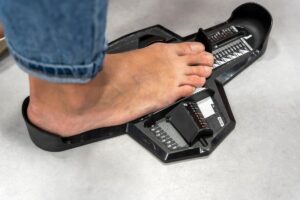Many individuals face daily challenges associated with having wide feet, but discovering the perfect footwear can be a simple and enjoyable journey. Issues such as discomfort, blisters, and a restricted selection of shoes can arise, yet comprehending the unique needs of your feet can significantly enhance your experience. Wearing shoes that don’t fit properly can lead to severe foot complications, including bunions and chronic pain. Recognizing that wide feet are completely normal is the first step towards achieving comfort, and choosing the right footwear can prevent long-term foot health problems. This comprehensive guide aims to enrich your understanding of wide feet and help you find shoes that seamlessly combine comfort with style.
Explore the Distinct Features of Wide Feet for Better Footwear Choices
Gaining a comprehensive understanding of your wide feet is crucial for making informed footwear selections. Research indicates that nearly 30% of adults have feet that exceed conventional shoe measurements. Factors such as genetics, age, and lifestyle choices significantly impact foot width. By acknowledging these elements, you can select shoes that are specifically designed to accommodate your unique foot shape, ensuring a comfortable fit that promotes overall foot health and well-being.
Embrace the Natural Diversity in Foot Structure for Enhanced Comfort
Your foot width varies naturally, similar to your height and body shape. Genetics plays a pivotal role in shaping your foot structure. If you have inherited wide feet from your family, remember that this trait is common and not a medical issue. Understanding these genetic influences empowers you to embrace your unique foot characteristics, enabling you to make informed footwear choices that provide the necessary support and space for your feet, leading to enhanced comfort and reduced foot problems.
Recognize the Impact of Life Changes on Foot Width
Life events can gradually influence the development of wide feet over time. Pregnancy can increase foot width by up to one full size, while aging and weight fluctuations can also alter your foot size. Additionally, extended periods of standing or specific medical conditions can contribute to the widening of the feet.
Being mindful of these changes allows you to adjust your footwear selections accordingly. Regularly measuring your feet is advisable, as their size may change over the years. Elements such as weight shifts, aging, and physical activity all contribute to these variations. Failing to adapt your shoes to these evolving needs can result in foot issues, including bunions, corns, and persistent discomfort.
Discover the Main Factors Contributing to Wide Feet
Understanding the core reasons behind your wider-than-average feet is essential for finding effective solutions. Several factors contribute to wide feet, including genetics, medical conditions, and lifestyle choices. By identifying these elements, you can find tailored solutions that enhance your comfort and foot health.
Investigate Genetic Factors Influencing Foot Width
Your family history and inherited foot structure are key determinants of your foot width from birth. Characteristics such as bone structure and arch type are often passed down through generations, shaping the development of your feet. By understanding these inherited traits, you can gain valuable insights into the unique shape of your feet and make better footwear selections that address your specific needs and comfort requirements.
Identify Medical Conditions That May Affect Foot Width
Sometimes, underlying health issues can result in wider feet. Common conditions such as diabetes, arthritis, and edema can lead to changes in the shape and size of your feet.
The impact of these medical conditions on foot width can be temporary or permanent. For instance, your feet may swell during pregnancy, following an injury, or due to circulation issues. Regular consultations with your healthcare provider are crucial to monitor any changes and address potential issues early on, ensuring that your footwear choices remain suitable for your evolving foot health.
Examine Lifestyle Factors That Can Influence Foot Width
Experts confirm that your daily habits significantly affect your foot width. Prolonged periods of standing, excess body weight, and poorly fitting footwear can gradually lead to wider feet over time.
Your lifestyle, combined with genetic and environmental factors, shapes your foot width. High-impact activities and inadequate shoe choices can exacerbate this change. The nature of your job and daily routines plays a vital role in maintaining your foot health and overall foot shape, making it essential to choose appropriate footwear for your activities.

Recognize the Health Consequences Associated with Wide Feet
In comparison to standard feet, wide feet can lead to serious health complications if not adequately supported. The width of your feet directly impacts your entire body’s alignment, which can significantly affect your joints, posture, and overall mobility. Research reveals that a staggering 72% of individuals do not wear shoes that fit correctly, a situation that can result in preventable foot ailments.
Investigate the Physical Consequences of Having Wide Feet
Approximately 65% of individuals with untreated wide feet experience chronic foot pain. When your foot support is insufficient, your body compensates by altering your walking pattern, which may lead to knee pain, hip discomfort, and lower back issues. Over time, these adjustments can result in lasting joint problems if you do not wear shoes that fit properly and provide the necessary support and cushioning for your feet.
Address Daily Comfort Challenges Faced by Individuals with Wide Feet
When your footwear does not accommodate your wide feet, daily activities can become increasingly difficult. You may suffer from immediate discomfort, blisters, and pressure points that restrict your ability to move freely. Studies indicate that 80% of individuals with wide feet report decreased activity levels due to foot discomfort.
The effects of wearing ill-fitting shoes go beyond just temporary discomfort. Your feet may develop painful conditions like bunions, corns, and calluses, which can negatively impact your balance and stability, making you more vulnerable to falls and injuries. Selecting the right footwear is essential for maintaining your foot health and overall well-being.
Discover Effective Footwear Solutions for Wide Feet
Finding the right footwear is crucial for individuals with wide feet, ensuring comfort and promoting overall foot health. Your shoes should provide ample space while also offering the necessary support and stability for your daily activities, whether they involve walking, running, or standing for extended periods.
The Importance of Accurate Measurement for Optimal Shoe Fit
Precise foot measurements are vital for selecting shoes that fit appropriately. Measure your feet at the end of the day when they are at their largest, and remember to measure both feet, as sizes can vary significantly from one foot to the other. This practice helps ensure that you choose shoes that cater to your unique foot shape and size, ultimately enhancing your comfort and reducing the risk of foot problems.
Identify the Most Suitable Shoe Styles for Comfort with Wide Feet
To effectively accommodate wide feet, certain shoe styles are more fitting than others. Understanding these styles can significantly enhance your comfort levels while ensuring adequate support.
| Feature | Benefit |
|---|---|
| Wide toe box | Facilitates natural toe spread |
| Adjustable closures | Provides a customizable fit |
| Breathable materials | Helps reduce swelling |
| Deep heel cup | Offers stability |
| Flexible sole | Adapts to foot shape |
- Athletic shoes featuring mesh uppers for enhanced breathability
- Sandals with adjustable straps for a tailored fit
- Loafers available in wide widths for additional comfort
- Boots designed with stretch panels to accommodate wider feet
For instance, certain shoe designs can significantly improve your comfort levels, providing the support your wide feet truly need.
| Shoe Type | Best Features |
|---|---|
| Running shoes | Extra width options for a better fit |
| Walking shoes | Roomy toe area to prevent discomfort |
| Casual shoes | Stretchable materials for adaptability |
| Dress shoes | Multiple width options for a personalized fit |
| Work boots | Wide-fit designs for all-day comfort |
Implement Essential Shopping Tips for Finding Comfortable Wide Feet Footwear
Your ability to locate comfortable shoes for wide feet hinges on careful planning and informed decision-making. Seek out specialty retailers that offer wide-width options and have knowledgeable staff ready to assist with accurate measurements. It’s best to shop in the afternoon when your feet are naturally at their widest, ensuring a fit that promotes comfort throughout the day.
Select Brands Known for Their Wide Feet Options to Enhance Your Choices
To find suitable footwear, prioritize brands recognized for their wide-width offerings, such as New Balance, Brooks, and ASICS. These brands design shoes with added room in the toe box and midfoot areas, leading to improved comfort for those with wide feet. Emphasizing quality construction and proper support is essential for ensuring your long-term satisfaction and comfort, making a notable difference in your daily activities.

Apply Expert Fitting Techniques for Maximum Comfort
Successful shoe purchases depend on effective fitting techniques. Follow these essential guidelines:
- Measure both feet while standing for the highest accuracy
- Ensure thumb-width space at the toe area for ultimate comfort
- Try shoes on with your regular socks for a more accurate fit
- Test the shoes by walking around in them to evaluate comfort
- Shop during the late afternoon when your feet are at their largest
Experiencing immediate comfort is critical for making the right shoe choice that supports your wide feet.
Fitting procedures require careful attention and patience. Consider these additional factors:
- Check for adequate arch support to maintain your foot health
- Ensure no pressure points exist that could lead to discomfort
- Verify heel stability for support during movement
- Test flexibility at the ball of the foot for ease of movement
- Explore various lacing techniques to customize fit
Paying close attention to these details will guide you in finding the ideal fit for your wide feet, enhancing your comfort and mobility.
Master Effective Care and Maintenance for Your Footwear
Proper care for your wide feet involves regular attention to maintain foot health and extend the life of your shoes. Incorporate thorough cleaning and drying of both shoes and feet into your daily routine to prevent issues such as fungal infections and unpleasant odors. Consistent upkeep can reduce foot pain by up to 40% and prolong the lifespan of your footwear, providing you with the comfort you need for daily activities.
Adopt Daily Practices to Promote Foot Health
Beneficial practices for your wide feet include rotating between different pairs of shoes to allow for proper drying time and minimize excessive wear. After each use, clean your shoes and consider using shoe trees to help maintain their shape. These straightforward yet effective measures can extend the lifespan of your shoes by up to 2 years and offer better support for your feet, ensuring they remain healthy and comfortable.
Implement Long-Term Foot Health Strategies for Lasting Comfort
Ongoing care for your wide feet necessitates consistent attention to prevent future complications. You should replace your shoes every 400-500 miles of walking or whenever you notice significant wear patterns. Regular foot measurements are also crucial, as your foot width can change over time, impacting your fit and comfort.
While maintaining your footwear, prioritize foot exercises and stretches. Engaging in regular foot exercises can enhance flexibility by 30% and alleviate discomfort. Ensure your feet receive adequate circulation by avoiding prolonged sitting, and consider using compression socks if your activities require extended standing.
Reflecting on your journey to find the ideal footwear for wide feet can be straightforward with the right knowledge and resources. By understanding your foot width, selecting brands that cater to wide sizes, and implementing effective measurement techniques, you can make more informed shoe choices. Your comfort is paramount, so take the time to try on various shoes and ensure they provide adequate space for your feet. Following these insightful tips and being mindful of how your shoes fit will lead you to footwear that supports your daily activities while keeping your feet healthy and free from discomfort.
Address Common Questions Regarding Wide Feet and Footwear
What is the best way to measure my feet for finding suitable wide-width shoes?
To accurately measure your feet, stand on a piece of paper while wearing your regular socks. Trace both feet and measure their length and width at the widest points. It is advisable to perform this measurement in the evening when your feet are at their largest. Compare these measurements to standard shoe size charts and select shoes that correspond to the measurements of your larger foot. Always take the time to test new shoes by walking around in them for several minutes to determine comfort and fit.
Which shoe features should individuals with wide feet prioritize for enhanced comfort?
Look for shoes that have a wide toe box to allow your toes to spread naturally. Seek out shoes labeled with “W” for wide or “EE” width designations. Opt for materials such as soft leather or breathable mesh that stretch and adapt to the shape of your feet. Choose shoes with adjustable features, like laces or straps, and avoid pointed toe designs in favor of rounded or square toe shapes for optimal comfort.
What measures can I take to prevent foot problems caused by incorrect shoe sizes?
Replace any shoes that show signs of significant wear and damage. Purchase shoes from brands that specialize in wide-width options to ensure a comfortable fit. Ensure your toes have enough space to move freely and comfortably. Consider using shoe inserts for additional support if needed, and alternate between different pairs of shoes daily to promote even wear. Regularly check your foot size, as feet can change over time, and discontinue wearing shoes that cause pain or discomfort.
The Article The Ultimate Wide Feet Guide: Concerns, Footwear Tips, and More appeared first on My Shoes Finder
The Article Wide Feet Guide: Essential Tips and Footwear Solutions Was Found On https://limitsofstrategy.com
The Article Wide Feet Solutions: Essential Tips and Footwear Guide First Appeared ON
: https://ad4sc.com





Comments are closed